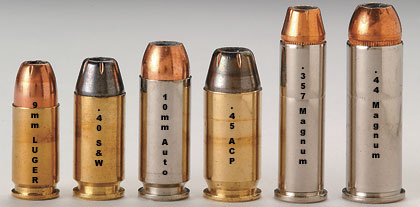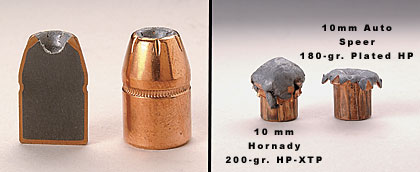January 04, 2011
By Rick Jamison
Does your handgun have the power to get the job done?
By Rick Jamison
 Because of the great assortment of styles and weights of handgun bullets, a wide variety of handgun cartridges can be used effectively for hunting North American game. |
If you've been hunting with a rifle and want to take up handgun hunting, a look at kinetic energy figures for your chosen handgun cartridge might give you pause. You might even wonder whether your handgun has the power necessary to get the job done.
This year, suppose that instead of using your favorite .30-06 elk rifle you decide to add a challenge to the hunt by going after one of the big boys with a .44 Magnum revolver. You know that people take elk with the .44 Magnum, but you're wondering how the stubby round stacks up with your .30-06, so you look at energy figures.
Advertisement
The Speer reloading manual reveals the .30-06 rifle produces 2670 foot-pounds (ft-lbs) of energy when firing a 165-grain bullet at 2700 fps. Turning to the .44 Magnum figures, you find that a 240-grain bullet going 1400 fps turns up only 1044 ft-lbs of energy--at the muzzle!
In some states to be legal for deer a rifle cartridge must turn up a minimum of 1000 ft-lbs of kinetic energy at 100 yards. Further, riflemen often consider 1500 ft-lbs of impact energy to be recommended for elk. So how can the .44 Magnum be considered at least adequate for elk when the .30-06 is considered not overly powerful?
Advertisement
I first got a hint to the answer to this question 30 years ago when I was testing bullets from .300 Winchester Magnum and .375 H&H Magnum rifles and a .44 Magnum revolver. While recovering bullets fired into wet newsprint I was surprised to find that hard-cast lead semiwadcutter bullets from the .44 Magnum penetrated deeper than the expanding rifle bullets. I mean, after all, a .375 H&H is considered to be adequate for bigger and tougher game than we even have in North America--and the little .44 Magnum revolver bullet out-penetrated it! I later found that even an expanding 240-grain bullet from a .44 Magnum would often shoot completely through a deer broadside.
Kinetic Energy Isn't Everything
Obviously, kinetic energy isn't everything, and there are other factors at work. A basic physics text tells us that kinetic energy is the energy of motion. Any object in motion has kinetic energy. Further, the kinetic energy of an object (bullet) is directly proportional to the square of its speed (velocity). For a twofold increase in speed, kinetic energy increases by a factor of four. For a threefold increase in speed, kinetic energy increases by a factor of nine and for a fourfold increase in speed, kinetic energy increases by a factor of 16. The basic formula for kinetic energy is KE equals 1/2 times mass times velocity squared, or KE=1/2 x MV2. Clearly, velocity is a more significant component of kinetic energy than is mass or bullet weight.
Another hint about the effectiveness of big bullets at low velocity came along about the same time that I was testing bullets in wet newsprint in the early 1970s. I was preparing for a deer and elk hunt with a .50-caliber Thompson/Center Hawken muzzleloader and was chronographing loads. I was a little discouraged by the low velocity turned up by a 370-grain T/C Maxi slug. It just did not compare with the velocity from my favorite .300 Winchester Magnum that I had used on so many elk. Muzzleloader sabots were not available back then.
I relayed my concern about the slow-moving slugs to John Wootters, the very knowledgeable gun writer. John told me that kinetic did not provide an accurate picture of the killing potential of large, slow-moving projectiles. He said that momentum was probably a better indicator in this class of projectiles.
Again, I turned to a basic physics text that explained that momentum is mass in motion. Momentum is the mass of an object times the velocity of the object. In this instance, less emphasis is placed on velocity than with the kinetic energy formula and more emphasis is placed on mass. Mass and velocity are given equal weight.
 Hard-cast bullets with blunt tips penetrate well and transfer energy. |
While the 165-grain bullet from the .30-06 has 2.6 times the kinetic energy of the .44 Magnum load, it has only 1.3 times the momentum. Either kinetic energy or momentum can be used to describe the "power" of a projectile, and both have a sound basis in physics. What has never been quantified exactly, however, is killing power or killing ability.
Answers Are In Actual Shooting
Here, we find that practical field examples from shooting game or empirical evidence from shooting into an expansion medium is the best test. Over the next few seasons my hunting partners and I shot several head of elk and deer with the muzzleloader. What we learned was that the 370-grain T/C Maxi slug would put an elk down quickly and probably more reliably than most centerfire .30-caliber rifles. We also learned that while the heavyweight .50-caliber Maxi slug is deadly on elk, a lightweight .50-caliber round ball is not. In fact, the round ball was not particularly impressive even on deer.
I also have learned through the years that handgun bullets of .400 diameter or larger work great on deer and boar. I have taken several deer, wild boar, and other game with the 10mm Auto. Here, a 200-grain bullet at nearly 1200 fps has proven mighty effective. If a bluntnosed hard-cast semiwadcutter bullet is used, it almost does not matter whether the bullet expands. It is still effective with reasonably placed shots.
As in any hunting situation, shot placement is important. A poorly placed shot will not put an elk down with authority, whether it's from a .375 H&H Magnum rifle or a .44 Magnum handgun. A traditional handgun is a limited-range firearm, but other types of handguns, such as the break-action single-shot Thompson/Center Encore and bolt-action Savage Striker, are chambered for bottleneck rifle cartridges and when used in conjunction with scopes these firearms are as accurate as a rifle. For purposes of this discussion, however, I'm talking about traditional semiautomatic and revolver rounds. With revolvers and semiautomatics we generally get close to game before shooting, and we tend to place our shots better.
A rifle bullet going fast carries a lot of kinetic energy. If a high-velo
city rifle bullet expands well, it transmits a high level of energy to game shortly after impact. Someone termed this "hydrostatic shock." The bullet also tends to destroy itself. Frontal diameter gets large and then smaller again as such a bullet penetrates, and expanded petals fold back along the bullet's shank. Lead at the front end of the bullet smears off under the high-velocity impact and the bullet loses weight. The large frontal diameter and loss of weight combine to reduce penetration. The greater the expansion, shock transmission, and weight loss, the less the penetration.
Kinetic energy is a measure of destructive potential, and it applies equally to both high-velocity rifle bullets and slow-moving handgun bullets. But projectiles with equal kinetic energy do not necessarily have equal killing power. After a high-velocity rifle bullet impacts, there are lots of variables related specifically to bullet performance. How it expands and transfers energy becomes very complex and dynamic. A high-velocity expanding bullet is constantly changing along its path through game. All sorts of bullet construction innovations have been employed to maintain bullet integrity under high-velocity impact. Manufacturers have gotten very good at it in recent years.
 Hard-cast bullets with blunt tips penetrate well and transfer energy. |
A handgun bullet is not so dependent on bullet construction. Jackets are thinner, but at relatively low velocity a jacket is not so critical. Not so much bullet weight is lost from low-velocity impact and penetration. The heavy bullet has enough momentum to allow it to penetrate well. While the destruction cavity may not be as large with a low-velocity impact, it's large enough and deeper. A longer destruction cavity is also more likely to extend through vital organs.
Bullet Design Is Crucial
It has become popular among hunters after large game with a handgun to use hard-cast nonexpanding bullets to maximize penetration depth. Remember: the smaller the frontal diameter after impact, the deeper the penetration.
This brings up another lesson I learned in the field. If you're using a nonexpanding bullet, a blunt, flatnose design is important. Shortly after I bought my first Government Model .45 ACP, I tired of plinking inanimate objects, and it was natural to go after something more challenging. Jackrabbits and coyotes were everywhere, and a running jackrabbit can really hone the hand/eye coordination as one of the big hares dodges around bushes in rapid departure. The same goes for called-in coyotes.
I had a lot of 230-grain roundnose FMJ ammo on hand that had worked great on tin cans and dirt clods. I figured that a big .45-caliber bullet would really flatten a jackrabbit. With even unfired bullet diameter being so large, I figured that expansion was not necessary. I was only partially correct. What I soon found was that the .45 ACP with hardball ammo was no more effective on jackrabbits or coyotes than a .22 rimfire had been, probably less so. I switched to 185- and 200-grain quick-expanding hollowpoint loadings in the .45 and varmints started hitting the dust hard. Hard-cast semiwadcutter loads also worked well.
When I pulled the hides off the rabbits and coyotes I could see the differences clearly. The slick hardball bullets appeared to simply have wedged through tissue without destroying much. In some instances it was not easy to find a bullet hole. The hollowpoints and semiwadcutters destroyed tissue along the bullet's path instead of pushing between muscle fibers, and there was obviously more energy transfer.
When I began handgunning in about 1960, even jacketed handgun bullets of an expanding type were almost nonexistent for handloading. Today, there is a wide variety of bullet weights and styles from every major maker in every caliber. You can buy expanding bullets that perform ideally on game from prairie dogs to moose in appropriate calibers.
 A 300-grain heavyweight bullet in .44 Magnum carries enough momentum to provide deep penetration at top velocity, making it adequate for elk-size game. |
When it comes to killing power with a handgun, conventional wisdom about rifle cartridges and kinetic energy goes right out the window. The momentum from a 240- to 300-grain .44 Magnum bullet, for example, is such that its killing power is adequate even for elk or moose though its kinetic energy is not great by rifle standards.
If you're wondering about the effectiveness of .44-caliber and larger projectiles, you can set your mind at ease. Pick a medium to heavy bluntnosed slug, and it will not even have to expand to be effective. Rounds like the .44 Magnum, .454 Casull, .480 Ruger, or .50 Action Express will do the job on game up to and including moose and elk. The 10mm Auto and .41 Magnum revolver rounds are great for deer and wild boar.
If you have been thinking about an added challenge, a traditional iron-sighted revolver might be just what you're looking for.
